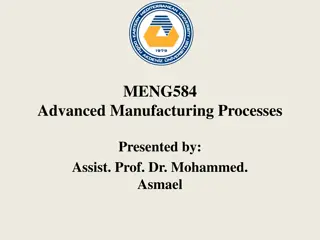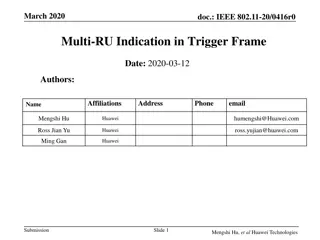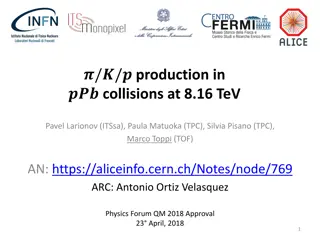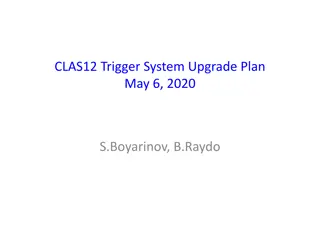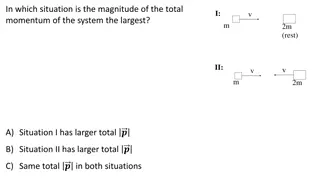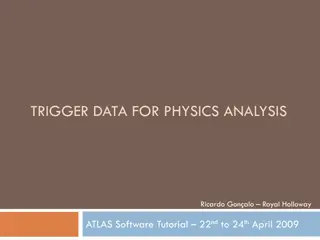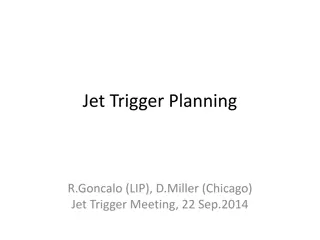Jet Trigger Study with ALICE EMCAL for PbPb Collisions at 5.5 TeV
Investigating jet triggers using the ALICE EMCAL detector in PbPb collisions at 5.5 TeV is crucial for understanding the properties of the produced jets. Masato Sano from the University of Tsukuba and Lawrence Berkeley National Laboratory, a Research Fellow of the Japan Society for the Promotion of Science, leads this research project. The study aims to analyze the characteristics of jets in heavy-ion collisions, providing valuable insights into the underlying physics processes.
Download Presentation

Please find below an Image/Link to download the presentation.
The content on the website is provided AS IS for your information and personal use only. It may not be sold, licensed, or shared on other websites without obtaining consent from the author.If you encounter any issues during the download, it is possible that the publisher has removed the file from their server.
You are allowed to download the files provided on this website for personal or commercial use, subject to the condition that they are used lawfully. All files are the property of their respective owners.
The content on the website is provided AS IS for your information and personal use only. It may not be sold, licensed, or shared on other websites without obtaining consent from the author.
E N D
Presentation Transcript
Study of jet trigger with ALICE EMCAL for PbPb 5.5TeV Masato Sano University of Tsukuba Lawrence Berkeley National Laboratory Research Fellow of the Japan Society for the Promotion of Science
Outline Motivation ALICE Detector Annual jet yield with ALICE : PbPb 5.5TeV ALICE trigger architecture Jet trigger performance : PbPb 5.5TeV Summary 2
Motivation Phys.Rev.Lett.91(2003) 072304 RHIC has discovered partonic energy loss in QGP These results are from the measurement of leading hadrons If jets can be measured in heavy ion environment, it must be more direct probe for parton energy loss and QGP property itself 3
ALICE Detector EMCAL : <110 | |<0.7 0and measurement E/E 11%/ E ITS, TPC, TRD : <2 | |<0.9 charged particle momentum determination. p/p 5% at 100GeV/c 4
Annual jet yield at ALICE Annual jet yield Nominal PbPb luminosity 1 running year Binary scaling from p+p (pythia6) FastJet, anti-kt algorithm is applied for jet reconstruction. see next talk by D. Sakata Huge cross section for jet production! 200k jets/year above100GeV We have lots of opportunity to use jets as a probe for the properties of QGP ALICE can t record all events Need to trigger 200k 200k 5
ALICE trigger architecture Limitations on data flow TPC gating frequency (500Hz) High level trigger input bandwidth (25GB/sec) Data taping bandwidth (1.25GB/sec) We have to select the interesting event efficiently trigger levels in ALICE (L0(1.2 s), L1(6.6 s), L2 and High level trigger) For heavy ion jet measurement with EMCAL, the trigger decision is at L1 and High level trigger L1 output should be < 500Hz (TPC gating frequency) < 25GB/sec (High level trigger input bandwidth) High level trigger output should be < 1.25GB/sec (Data taping bandwidth) PbPb L0 frequency : 4kHz Data rate : 80GB/sec L1 High Level Trigger Fully reconstructed event Subsystem information only 6
Jet trigger enhancement with EMCAL Trigger gain : Comparison between Jets triggered by and reconstructed with EMCAL Jets triggered by and reconstructed with EMCAL and Jets by geometrical triggers and reconstructed with TPC Jets by geometrical triggers and reconstructed with TPC Applicable for ETJet>100GeV Jet trigger with EMCAL will enhance high pt jet yield 7
Study of jet trigger performance : PbPb 5.5 TeV To evaluate the jet trigger performance in PbPb collision with ALICE EMCAL, I analyzed the PYTHIA events merged with HIJING events, and applied the L1 trigger and High level trigger. L1 trigger Patch trigger algorithm is used with subsystem information only (EMCAL, V0) Search the square patch which have maximum amplitude in EMCAL acc. If the amplitude is above the threshold, we accept the event EMCAL High level trigger Fully reconstructed event information (tracks, clusters in EMCAL, , etc) Fastjet Anti-kt algorithm (R=0.4) Search the jet which have maximum pTinside EMCAL acc. If the pTis above the threshold, we accept the event 8
Background rejection : PbPb 5.5TeV 110Hz 110Hz Left plot : Maximum patch amplitude distribution weighted by data volume Background only (HIJING) Applied cut to reduce data volume by factor 10 Right plot : L1 rejection vs L1 output frequency Rejection 10 L1 output 110Hz, 8GB/sec 9
Trigger bias on jet yield : PbPb 5.5TeV Upper plot : Jet yield as a function of jet pTfor pythia before/after trigger Bottom plot : Jet trigger efficiency Rejections are 10 and 40 for L1 trigger and High level trigger respectively L1 output : 110Hz , 8GB/sec L1 output : 110Hz , 8GB/sec HLT output : 0.2GB/sec HLT output : 0.2GB/sec We have 90 % efficiency at above 80GeV/c for these rejections 90% 90% 10
Summary Jet Trigger performance was evaluated for PbPb 5.5TeV Jet trigger efficiency is greater than 90% above 80GeV/c with the following rejections L1 HLT : 1/40 : 1/10 L1 output HLT output : 8GB/sec, 110Hz : 0.2GB/sec These output are satisfied with the requirements (TPC gating frequency, High level trigger input bandwidth and data taping bandwidth) Outlook Centrality dependence of jet trigger performance Jet trigger performance with the jet quenching model Jet trigger performance for pp 11
Back up 12
ALICE Detector ITS, TPC, TRD : <2 | |<0.9 charged particle momentum determination. p/p 5% at 100GeV/c EMCAL : <110 | |<0.7 0and measurement E/E 11%/ E JCAL : Upgrade of electro magnetic calorimeter in ALICE Sitting on back to back side of existent EMCAL in azimuthal angle < 60 , <1.4 Dijet, pi0-jet, gamma-jet correlation measurement. 13
Annual jet yield at ALICE Annual yield for various jets are calculated. Inclusive jet with R=0.4 in EMCAL Inclusive jet with R=0.2 in EMCAL Jet1 (in Jcal) jet2(in EMCAL) (in Jcal) jet (in EMCAL) (in Jcal) jet (in EMCAL) Nominal PbPb luminosity for 2 months. Binary scaling from p+p (pythia6) FastJet, anti-kt algorithm is applied for jet reconstruction. We have lots of opportunity to use jets as a probe for the property of QGP !! 14 Y.Miake, P.Jacobs, H.Yokoyama, M.Sano,
Response of the L1 & HLT Left plot : for L1 Correlation between jet pTin pythia(X axis) and amplitude of MaxPatch for L1 in pythia+Hijing(Y axis) . For L1 we can use only partial information like EMCAL cell, V0 and etc. therefore broad correlation can be seen. Right plot : for HLT Correlation between jet pTin pythia(X axis) and pTof Maximum Jet for HLT in pythia+Hijing(Y axis) . For HLT we can use the fully reconstruced information, so much sharper correlation can be seen than L1. 16
Jet energy resolution ALICE EMCAL technical design report 24









